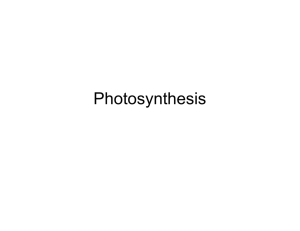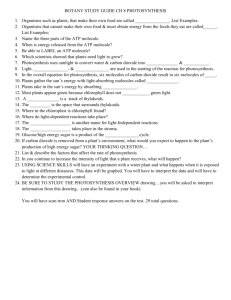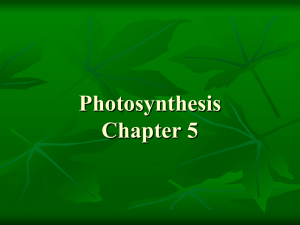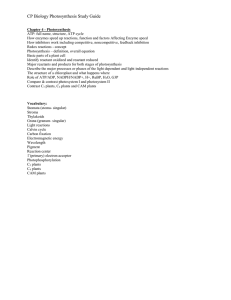Photosynthesis: Light-Dependent & Independent Reactions
advertisement
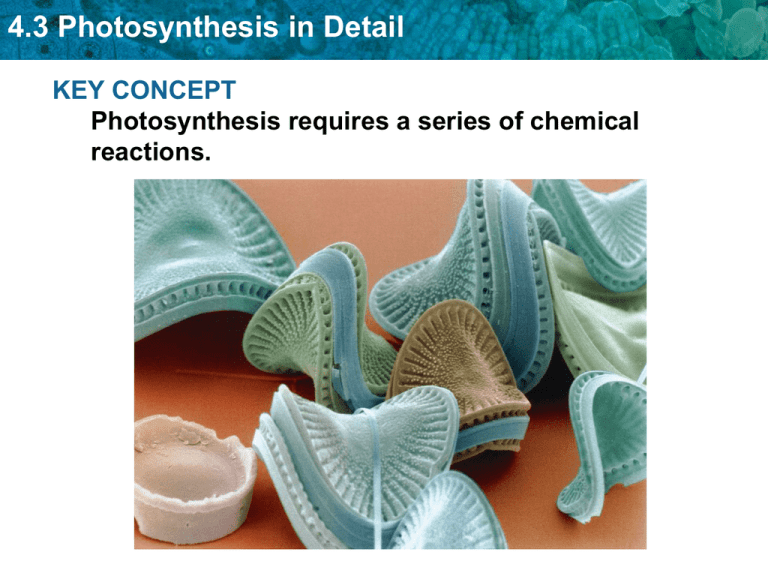
4.3 Photosynthesis in Detail KEY CONCEPT Photosynthesis requires a series of chemical reactions. 4.3 Photosynthesis in Detail Objectives • Describe the light-dependent reactions in which energy is captured. • Describe the light-independent reactions in which sugar is produced. 4.3 Photosynthesis in Detail Vocabulary • Photosystem – Series of light-absorbing pigments and proteins that capture and transfer energy in the thylakoid membrane. • Electron Transport Chain – Series of proteins in the thylakoid and mitochondrial membranes that aid in converting ADP to ATP by transferring electrons. • ATP synthase – Enzyme that catalyzes the reaction that adds a high-energy phosphate group to ADP to form ATP. • Calvin Cycle – Process by which a photosynthetic organism uses energy to synthesize simple sugars from CO2. 4.3 Photosynthesis in Detail The first stage of photosynthesis captures and transfers energy. • The light-dependent reactions include groups of molecules called photosystems. 4.3 Photosynthesis in Detail • Photosystem II captures and transfers energy. – chlorophyll absorbs energy from sunlight – energized electrons enter electron transport chain – water molecules are split – oxygen is released as waste – hydrogen ions are transported across thylakoid membrane 4.3 Photosynthesis in Detail • Photosystem I captures energy and produces energycarrying molecules. – chlorophyll absorbs energy from sunlight – energized electrons are used to make NADPH – NADPH is transferred to light-independent reactions 4.3 Photosynthesis in Detail • The light-dependent reactions produce ATP. – hydrogen ions flow through a channel in the thylakoid membrane – ATP synthase attached to the channel makes ATP 4.3 Photosynthesis in Detail The second stage of photosynthesis uses energy from the first stage to make sugars. • Light-independent reactions occur in the stroma and use CO2 molecules. 4.3 Photosynthesis in Detail • A molecule of glucose is formed as it stores some of the energy captured from sunlight. – carbon dioxide molecules enter the Calvin cycle – energy is added and carbon molecules are rearranged – a high-energy three-carbon molecule leaves the cycle 4.3 Photosynthesis in Detail • A molecule of glucose is formed as it stores some of the energy captured from sunlight. – two three-carbon molecules bond to form a sugar – remaining molecules stay in the cycle 4.3 Photosynthesis in Detail Question/Answer • Where do the light-dependent reactions occur? – Thylakoid membrane of chloroplast • What is the source of the electrons in the electrontransport chain? – Chlorophyll • How are the electrons released from the water molecules used? – To replace energized electrons that leave the chlorophyll. What role do these electrons play? • What role do these electrons play? – They provide energy to move hydrogen ions into the thylakoid and to produce molecules of NADPH. 4.3 Photosynthesis in Detail Question/Answer • What two energy carriers are produced? – NADPH and ATP • In what step is active transport occurring? Passive transport? – Step 3 – Step 6 • Where in the chloroplast do light-independent reactions occur? – Stroma • Where are ATP and NADPH coming from? – Light-dependent reactions • Why are these reactions called a cycle? – The five-carbon molecule of the process is regenerated, so the cycle continues. 4.3 Photosynthesis in Detail Question/Answer • How does the Calvin Cycle build sugar molecules? – Carbon dioxide is added to five-carbon molecules in the cycle. Energy from ATP and NADPH is used in a series of chemical reactions that build the threecarbon molecules needed to form a six-carbon sugar.


